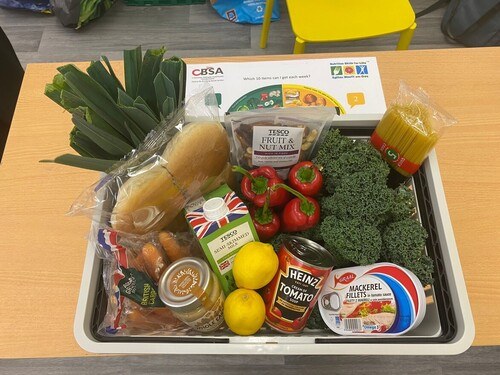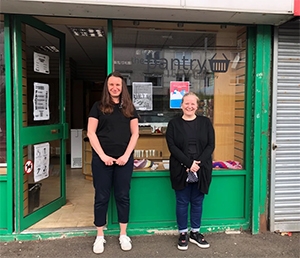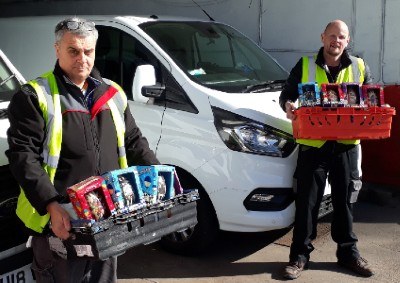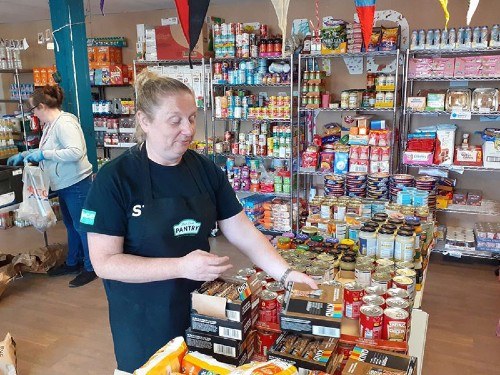
Food aid
We all recognise that food banks should not be necessary. But there are currently around 2,400 of them across the UK distributing emergency food aid and providing a helping hand.
Here we share practical tips from food banks we’ve supported over the years, providing inspiration if you’re thinking of opening one in your community.
Remember that there are many distinct types of food aid that work in different contexts with different challenges and opportunities. Read our article to learn more about the various other kinds of food aid, including pantries, community larders and social supermarkets.
Listen to this article
You can listen to this article as a sound recording, lasting 22 minutes and 15 seconds, by clicking the button below.
1. Building and managing food supply

Managing your stock to ensure you’ve a good mix of fresh and non-perishable foods is not easy. You may find it difficult to source certain items while learning that others are frequently donated.
Some are finding it harder than ever to manage supply as demand is going up while some suppliers may not be able to be as generous as before.
Here we share a few ideas on how you can make sure you’ve got a more reliable, steady supply of food.
Source a range of food from multiple suppliers
Ideally, food should come from multiple sources as even large suppliers may not be able to consistently provide everything a food bank needs.
Many start by building relationships with local and national supermarkets and shops, which may be able to donate surplus food, or to provide discounts. But there are other options too:
- Many food banks work with FareShare, the national network of charitable food redistributors. This requires a small membership fee. Organisations like The Trussell Trust, Independent Food Aid Network (IFAN), and The Scottish Pantry Network also support food aid providers up and down the country.
- Contact local farms, cafés, cinemas, takeaways and restaurants to see if they have surplus food they will donate. Many of our grant holders also work with big suppliers like bakers.
- Cost of living increases may make it harder for small food businesses to offer discounts. You could consider sourcing different types of surplus food – not just food that is going out of date, but also food that is being rebranded or not selling well, but be mindful that people need nutritional food, not fashionable products that shops can’t sell.
- You can apply for grants to support your food bank. GrantNav, a national grants database operated by 360Giving, gives you an idea of funders who’ve previously supported food banks. You may also want to have a look at the Government’s new Find a grant service.
Partner with other community groups and food networks
Allotment groups, farms, community growing projects, or even fruit-picking teams in your area might be able to supply local produce.
If you have your own outdoor space, you could consider recruiting volunteer gardeners to set up a vegetable patch, or even keep chickens for a steady supply of eggs.
Local food networks could make it easier for you to work with others in the area. You could check if there’s one nearby, for example one of the 80 food poverty alliances. Links to these networks don’t need to be formal: the important part is the commitment to work together when it benefits the community.
Ask for support
Groups we support have successfully campaigned for food and cash donations from businesses and the public. Here are some ideas that have worked for them:
- Advertise: try setting up a fundraising table at local festivals or events, or putting up posters at allotments, asking for fresh produce.
- Be creative. Food banks have run “Reverse Advent” campaigns for Christmas, where people put one item in a box every day for 25 days, donating to the food bank at the end.
- Seek sponsorship from local businesses and clubs.
- Could a local press story drum up interest and support while increasing awareness?
- Can friendly customer-facing local businesses keep a collection pot on the counter?
- Word of mouth can mean one donation leads to another. Raven House Trust put a call for donations in a local school’s newsletter. A parent saw it, and arranged a donation from their employer.
Work with other food banks
During times of high demand, you might find multiple food banks approaching the same businesses to ask for donations. Finding donations in scarce times can be particularly difficult for new food banks, who may not yet have the local connections and public awareness to get what they need.
Instead of working independently, you could consider connecting with others in your area and help one another through peaks and troughs. You can find out about others in your area from the Find a Food Bank service of the Trussell Trust, or check out the IFAN member list.
In areas where there are other food banks, think carefully about whether a new initiative would genuinely add value, or if it might be more appropriate to support an existing one.
In Lisburn, a newly established food bank Storehouse Trust immediately contacted another local food bank to minimise duplication. The group is also working with schools, a debt advice service, and Citizens Advice to make sure their service reaches those most in need.
Make provision to buy items to fill gaps
While you can campaign for donations, or collaborate with others to cover shortages, it may still be necessary to buy in supplies at retail price. For example, this may be needed to make sure you have culturally appropriate foods, where few suppliers in your area are able to stock or supply these.
Some grant holders have found it useful to build up enough financial reserves to be able to purchase goods when donations fluctuate.
To make most of limited resources, some food projects promote existing government schemes like Healthy Start, also known as Best Start Foods in Scotland. These help towards the cost of fruit, vegetables, milk and infant formula for pregnant women on low-incomes, and families with young children.
The South Belfast Food Alliance successfully campaigned for more shops to accept Healthy Start vouchers. This meant the food bank could focus on products that weren’t readily available. The Brighton and Hove Food Partnership promoted Healthy Start through leaflets and social media, and by raising awareness among food bank, charity and public sector staff. This led to a significant increase in the uptake of the vouchers – including 80% in one area.
2. Working with customers

As well as keeping shelves stocked, food banks also need to keep their supplies relevant, recognising that customers have different and changing needs. Here are some questions to think about.
Understand your customers’ needs
As much as possible, your food supply should match demand. So you may want to think about how you’ll identify what your customers do and don’t want. For example, you might want to think:
- Are there foods that are difficult for people to buy at an affordable price in your area, like ingredients for Indian, Chinese, eastern European or Caribbean recipes?
- Can you provide halal or kosher food, plant-based proteins, or food for those who take medication that affects what they can eat? As part of the Cambridge Food Power alliance, the Karim Foundation teamed up with local independent businesses to offer appropriate food during Ramadan.
- And are your customers used to eating foods like tinned vegetables and soups? There are some who aren’t, so there is a risk that those might go to waste.
You can find out more about what your customers want and need, simply by getting to know them during collections or dropoffs. Or you could run a short survey or work with referral partners, like other charities, social workers, schools and advice organisations.
Provide no-cook options
It isn’t helpful to provide raw food if people can’t afford to put the oven on or use the cooker. In some cases, people have had to switch off their fridges and freezers, so both cooking and storage can be a problem.
If you can, try to supply some food that doesn’t need much gas or electricity to prepare. Some food banks have provided “kettle packs” for those who don’t have cooking facilities, with instant food that can be made with hot water. Other options include microwaveable meals, or cold food like cereal. The Trussell Trust recognises that kettle packs don’t meet the same nutritional standards as its standard parcels. These low- or no-cook foods could be offered alongside healthier options like fresh fruit and vegetables that don’t need cooking.
If you have access to a kitchen and a pool of volunteers, you could look at providing pre-cooked hot meals for a more nutritious option that people don’t need to prepare.
Offer people dignity and choice
Most people prefer being able to choose their food, rather than being given a pre-selected parcel. And they’re often readier to accept food aid when they feel more like a customer than a recipient of charity.
Some groups run a hybrid food bank and food pantry – a membership shop where people can choose their own items, usually with a retail value of £20–£25, for a subsidised price, often around £5.
Edinburgh’s Community One Stop Shop encourages its food bank users to join their low-cost food pantry, helping them to rely less on the food bank. If a customer is struggling, the Rose Food Hub in Coventry can waive its £5 weekly membership for a short period.
If you don’t run a food pantry or similar service, you can signpost to any that are locally available. Your Local Pantry’s website has a postcode search, so you can find the nearest pantry in their network.
Find ways to minimise stigma
There is still stigma and shame associated with food banks. People may feel they don’t deserve food aid, or – particularly if they have jobs or don’t have children – that other people should be a higher priority.
People don’t like taking something for nothing. So finding ways for them to contribute, perhaps with a small donation or by volunteering some time, can make it easier to accept help.
You could encourage donations through a “pay as you feel” or “pay it forward” model. Could customers share their skills and expertise in return for donations, such as through cooking, crafting or growing lessons?
Food Power found that warm relationships between staff and customers encouraged people to volunteer, as a way of giving back to the community that helped them.
Whatever the opportunities are, it’s worth making sure that customers are aware of how they could help, and how their contribution would be valued.
Promote the benefits you bring to your community
People may feel more comfortable receiving support when they can see that the wider community will benefit. In Middlesbrough, surplus food pantries are called “EcoShops” and described as environmental projects: by supplying surplus food that would otherwise go to landfill, they’re helping to solve an environmental problem. People feel less that they’re receiving charity, and more that they’re doing their bit to reduce food waste.
Lots of people wouldn’t access the food bank, particularly people who were struggling but in work. The food bank is there for crisis, not to provide ongoing support for people who are struggling to make ends meet.Sam Froud Powell, Action in Caerau and Ely, talking about the food pantry his organisation runs at The Dusty Forge, a former pub.
3. More than just food

Food banks often provide more than food. They play an important role in communities, connecting people, providing a listening ear, and helping people to get back on their feet.
Here are some tips about what else your food bank could offer by working with others.
Work with others to widen your offer
Many food banks provide basic toiletries, like soap and toilet roll and working with organisations like baby banks or those that offer second-hand school uniform swaps can bring real benefits to customers with young families.
Seeds and gardening tools can help people start to grow some of their own food. Slow cookers or air fryers can cook nutritious meals while using less energy, helping people also cut down on their energy bills.
Donated items can also help people’s mental wellbeing. Hazel Grove food bank stock skin care products and Easter eggs, because “people are coming here with so many difficulties and problems with their lives. It’s nice to send them away with something extra in their bags so they can treat themselves or treat their family”.
Make time to talk to your customers
A conversation is more effective than a signposting leaflet in a food parcel. And freeing up time for staff and volunteers to listen to what’s going on in people’s lives can make a big difference. Talking to you might be the first time a customer has spoken to anyone about their difficulties.
Consider providing seating for people while they wait – both for accessibility and to make your space feel more welcoming. Other food banks have recruited volunteers as interpreters, widening the reach and making sure people are understood.
Action in Caerau and Ely added a library of recipe books to their waiting area. Volunteers were on hand to talk about sources of support and encouraged people to share their expertise about managing money and cooking on a budget, making then feel knowledgeable and valued.
Link with other support services
Staff from other services, like job centres, Citizens Advice, mental health charities, addiction services, debt advisors, and tool libraries can come in to run pop-up sessions, sharing advice and encouraging people to try other kinds of support.
A Better Start Southend used food banks to advertise their breastfeeding support and speech therapy service. A regular presence at the food bank was a good way for staff “to build relationships and trust with local families who may be reluctant to come to a group.”
If you have the space and volunteers, you could try putting on your own workshops about cooking healthy, affordable meals, reducing energy bills, growing food, and other ways to maximise household income. But even just setting up social occasions like community meals can create opportunities for informal connections.
From a food bank to a community hub
Bangor Foodbank received a £184,590 grant in 2021 to expand on the emergency food aid they’d been providing for eight years.
They used the grant to set up a bigger, integrated service providing food, mental health advice, benefits advice, and help with utility bills, debt, housing and employment.
The change was a success, creating a resource hub for the community that meant people could have a face-to-face conversation with someone when they went to pick up food, rather than making appointments with different organisations in different places.
The group is now also running a Cooking Academy as well as Community First Aid and Managing Money with Confidence courses.
Community fridges bringing people together
In 2019, residents in Poole set up Community Fridge in Branksome Library to share surplus food. Following lockdown, they were saving so much food they opened a second fridge at Rossmore Library.
What started as a small, resident led initiative has now grown into an initiative supporting 200 households per week. Supporting people in an area of deprivation, the fridges are run entirely by a team of 20 volunteers who make 55 collections a week from local supermarkets and stores – in addition to taking ad hoc donations from allotments, gardens, families, hotels and restaurants.
The fridges are now driving traffic to the two libraries and customers have created their own mini-community – sharing recipes, cooking tips and photos of their creations.
4. Practicalities

There are some practicalities your food bank may want to think about.
Make it easy for your customers
It’s important that your food bank is in an accessible location, and that you can welcome everyone into the building. If not you will need to consider additional ways to reach your customers.
- Is your building accessible to people with disabilities or mobility problems? Is there space for buggies or wheelchairs? If not, how can you improve access? Could a grant help you to make adjustments to remove these barriers?
- It’s important to make it easy for customers to get to you and transport their food home again. Are you near to reliable public transport? Is there somewhere safe to leave bikes. Can people park easily nearby?
- Food deliveries are a lifeline for those with limited mobility, or those who struggle to cover bus fares. But they mean fuel costs for you, which may limit how many deliveries you can afford to make. Can other local groups, such as bikers or scouts groups, help to make deliveries? Could you partner with local businesses which also do deliveries – for occasional or regular help? Or could you run pop-ups in accessible locations for the community, like schools, village halls or high streets?
- Although they can be expensive to maintain and run, mobile food banks can go where they’re needed. We awarded £89,465 to Moray Food Plus in Scotland to start a Big Blue mobile pantry to get affordable essentials to remote rural areas.
- Swap boxes – where people exchange foods – are a discreet way to offer help. People can access them without explaining their situation to anyone, and can even avoid being seen using them. They also help people who can’t get to a food bank because of work or caring responsibilities.
Balfron’s food exchange box in Scotland, converted from a red telephone box, allows anyone to obtain or donate food at their convenience. The telephone box is now full of non-perishable goods, and a campaign with Co-op has raised nearly £800.
There is no formula for a good food swap initiative. It can be anything – a shelving unit outside a shop with free loaves of bread, or a wheelbarrow of fresh fruit and vegetables outside a community centre. While they cannot serve as many people as a food bank, swap boxes are easier to maintain, needing fewer volunteers or staff.
Think about the space you’ll need
Food banks need space to store, organise and pack food. The bigger the space, the more people you can serve. So if you plan to scale up, you need to make sure you have adequate storage. In some cases, we’ve funded groups to move to bigger premises, and buy essential equipment.
Old and second-hand fridges and freezers can be cheaper to buy, but may be much less energy efficient than new ones – so factor the cost of energy bills into your decision.
Have a plan for finding and retaining volunteers
Food banks lost many long-standing volunteers during the pandemic, and we’re now hearing that some volunteers are resigning to take up second jobs.
There are a few things you could think about doing:
- Is it possible to make sure volunteers get something in return for their time? FareShare’s warehouse for Glasgow and West Scotland is staffed by participants from Move On, a charity working with young people who have been in care. By working in FareShare’s warehouse, young people gain experience and training for jobs in high demand, including delivery driving and forklift certification.
- Is it possible to dedicate a member staff to volunteer management – with time set aside to find, coordinate, support, and train volunteers so that they feel supported and enabled? The Smethwick Foodbank used a National Lottery grant of £8,600 to hire a part time co-ordinator to organise rotas, training and support for volunteers who help to serve their 1,400 monthly customers.
- Have you advertised your volunteer posts using local platforms, or the Trussell Trust volunteer recruitment site?
- Does the background of volunteers reflect the community you serve? Making sure it does could open up new ideas for volunteer recruitment.
Want to find out more or share your story?
If you have experience in running food banks and have great examples to share about what’s worked for you, please do consider sharing them with us at knowledge@tnlcommunityfund.org.uk.
You may also want to read what we’ve learned about food aid during the cost of living crisis and earlier stages of the COVID-19 pandemic.